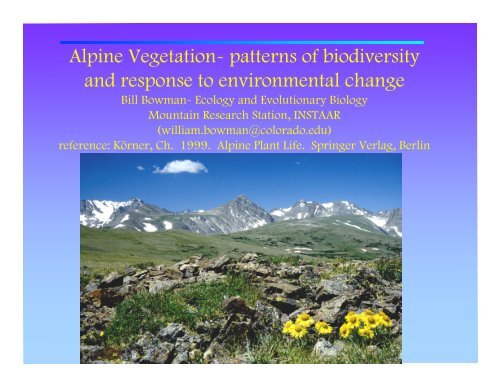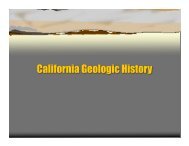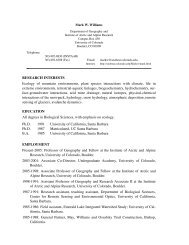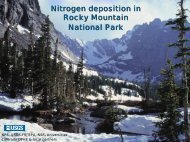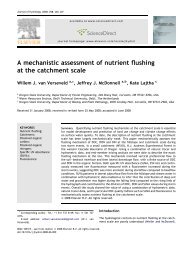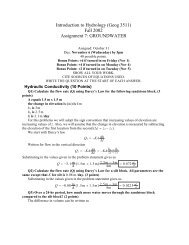Alpine Vegetation- patterns of biodiversity and response to ...
Alpine Vegetation- patterns of biodiversity and response to ...
Alpine Vegetation- patterns of biodiversity and response to ...
Create successful ePaper yourself
Turn your PDF publications into a flip-book with our unique Google optimized e-Paper software.
<strong>Alpine</strong> <strong>Vegetation</strong>- <strong>patterns</strong> <strong>of</strong> <strong>biodiversity</strong><br />
<strong>and</strong> <strong>response</strong> <strong>to</strong> environmental change<br />
Bill Bowman- Ecology <strong>and</strong> Evolutionary Biology<br />
Mountain Research Station, INSTAAR<br />
(william.bowman@colorado.edu)<br />
reference: Körner, Ch. 1999. <strong>Alpine</strong> Plant Life. Springer Verlag, Berlin
What is the alpine<br />
Is it tundra<br />
Nival<br />
<strong>Alpine</strong><br />
treeline<br />
Subalpine<br />
Montane
elevation <strong>of</strong> treeline corresponds<br />
with:<br />
1) minimum growing season<br />
temperature around 6 °C<br />
2) wind<br />
3) geomorphic disturbance- avalanches<br />
krummholz- "twisted wood"
Global distribution <strong>of</strong> treeline<br />
from Körner, 1999<br />
large variation in<br />
altitude at midlatitudes<br />
associated with continentalitytreelines<br />
lower in moist, maritime<br />
locations
<strong>Alpine</strong> is a globally distributed biomeplants<br />
have similar<br />
"growth forms:"<br />
graminoids<br />
(grasses, sedges)<br />
forbs<br />
(broad leaved<br />
herbaceous plants)<br />
prostrate shrubs
<strong>Alpine</strong> environmental conditions:<br />
cold<br />
temperatures may change rapidly<br />
windy (mainly temperate zone)<br />
soils <strong>of</strong>ten poorly weathered<br />
low water <strong>and</strong> nutrient availability<br />
high UV irradiance (although <strong>of</strong>fset<br />
by cloud cover)<br />
low p(CO 2 ) - dependent on elevation
Adaptations <strong>to</strong> the alpine environment include:<br />
being short<br />
high investment in<strong>to</strong><br />
belowground biomass (high<br />
root:shoot ratio)<br />
low growth rates<br />
<strong>to</strong>lerance <strong>to</strong> low temperatures<br />
(= in<strong>to</strong>lerance <strong>of</strong> high<br />
temperatures)
<strong>Alpine</strong> is an extensive biome- globally distributed
How has<br />
Pleis<strong>to</strong>cene<br />
glaciation<br />
influenced alpine<br />
diversity <strong>and</strong><br />
plant<br />
distribution
Continuous <strong>and</strong> isolated alpine habitat: Colorado<br />
interglacial (present)<br />
Glacial (ca. 20K BP)
i<br />
c<br />
e<br />
p<br />
s<br />
f<br />
o<br />
r<br />
e<br />
b<br />
m<br />
u<br />
n<br />
300<br />
200<br />
100<br />
c<br />
i<br />
m<br />
e<br />
d<br />
n<br />
e<br />
0<br />
35 40 45 50<br />
a<br />
6<br />
r<br />
o<br />
l<br />
f<br />
f<br />
o<br />
4<br />
2<br />
n.s.<br />
u<br />
c<br />
r<br />
i<br />
c<br />
Biogeographic trends in Rocky Mountain alpine plant diversity<br />
~ same number species<br />
a<br />
r<br />
o<br />
l<br />
f<br />
f<br />
o<br />
%<br />
s<br />
e<br />
i<br />
c<br />
e<br />
p<br />
s<br />
50<br />
40<br />
30<br />
20<br />
35 40 45 50<br />
r 2 =0.46, P< 0.01<br />
r 2 =0.49<br />
P< 0.01<br />
more Arctic species <strong>to</strong> north<br />
more endemic species <strong>to</strong> south<br />
%<br />
0<br />
35 40 45 50<br />
Latitude (degrees)
Biogeographic similarities (after Hadley 1987)<br />
Sørenson’s index<br />
Bear<strong>to</strong>oth<br />
(50-83)<br />
Absoroka<br />
Gros Ventre<br />
Te<strong>to</strong>n<br />
51<br />
Big Horn<br />
Wind River<br />
58 51<br />
Uintah<br />
44<br />
48<br />
Needles<br />
54<br />
Medicine Bow<br />
59<br />
Indian Peaks<br />
50<br />
Sangre de Cris<strong>to</strong>s<br />
San Fransisco Peaks<br />
34
Global Plant Diversity
Regional scale plant diversity in S. Rockies; the influence <strong>of</strong><br />
mountains:<br />
Weld County: ~600 species<br />
Boulder County: 1550 species<br />
(50% <strong>of</strong> flora <strong>of</strong> Colorado)
MOUNTAINS<br />
• Have the highest plant species diversity<br />
• High mountain environments have a high<br />
percentage <strong>of</strong> endemic plants<br />
• <strong>Alpine</strong> areas have a much higher plant<br />
diversity than forested areas
Fellfield Fellfield<br />
<strong>Alpine</strong> Meso<strong>to</strong>pographic Gradient<br />
(After Billings)<br />
Prevailing wind<br />
Snowbed<br />
snow<br />
Snowbed<br />
Moist<br />
Meadow Wet<br />
Meadow<br />
Dry<br />
Meadow<br />
Similarity <strong>of</strong> flora among communities<br />
(Sørenson’s index): 25-77%
What controls variation in diversity across the l<strong>and</strong>scape<br />
soil resources<br />
y<br />
t<br />
i<br />
s<br />
r<br />
e<br />
v<br />
i<br />
D<br />
1.0<br />
0.5<br />
Decreasing belowground<br />
competition; more spp. coexist<br />
Increasing stress<br />
<strong>and</strong> belowground<br />
competition<br />
Increasing aboveground<br />
competition; competitive<br />
exclusion<br />
0.0<br />
0.0 0.2 0.4 0.6 0.8 1.0<br />
Soil Resource Availability
)<br />
'<br />
H<br />
(<br />
<strong>Alpine</strong> plant diversity relationship <strong>to</strong> soil N+P availability on<br />
Niwot Ridge<br />
y<br />
t<br />
i<br />
s<br />
r<br />
e<br />
v<br />
i<br />
D<br />
3<br />
2<br />
1<br />
other fac<strong>to</strong>rs:<br />
disturbance (climate &<br />
animal)<br />
water availability<br />
0<br />
0.0 0.1 0.2 0.3 0.4 0.5 0.6 0.7<br />
N <strong>and</strong> P supply (proportion <strong>of</strong><br />
maximum)
Environmental change in alpine - primarily “indirect:”<br />
climate, N deposition, stra<strong>to</strong>spheric ozone degredation (↑UV)<br />
locally most immediate threat is N deposition
Colorado ranks 3rd in U.S. population growth, with most <strong>of</strong> the increase in the<br />
Front Range urban corridor:<br />
source: William Travis<br />
CU Geography
Where in the alpine l<strong>and</strong>scape is change most probable<br />
Snow is an effective reservoir <strong>of</strong><br />
atmospheric N inputs<br />
Moist meadows- elevated N<br />
inputs due <strong>to</strong> <strong>to</strong>pographic location
)<br />
e<br />
u<br />
s<br />
s<br />
( i<br />
g<br />
t<br />
1<br />
e<br />
-N<br />
k<br />
a<br />
tµg<br />
p<br />
u<br />
750<br />
500<br />
250<br />
15<br />
N labeling experiment:<br />
Moist meadow plant N uptake from snow<br />
(% growth dem<strong>and</strong>)<br />
c (13)<br />
b<br />
(5)<br />
b<br />
(6)<br />
b<br />
(10)<br />
5 N<br />
1<br />
a<br />
(1)<br />
(grass)<br />
D eschampsia 0<br />
A comastylis A rtemisia B is<strong>to</strong>rta C altha<br />
}<br />
+ responder <strong>to</strong> N non responders
Implications <strong>of</strong> differential N uptake by alpine vegetation:<br />
change in plant species composition ("weedy" native<br />
species)- may already be occurring<br />
change in ecosystem properties:<br />
> enhancement <strong>of</strong> N cycling (net N mineralization<br />
<strong>and</strong> nitrification) rates- loss <strong>of</strong> N from terrestrial <strong>to</strong><br />
aquatic ecosystems<br />
> greater climatic control (lower biological control)<br />
over variation in primary production


